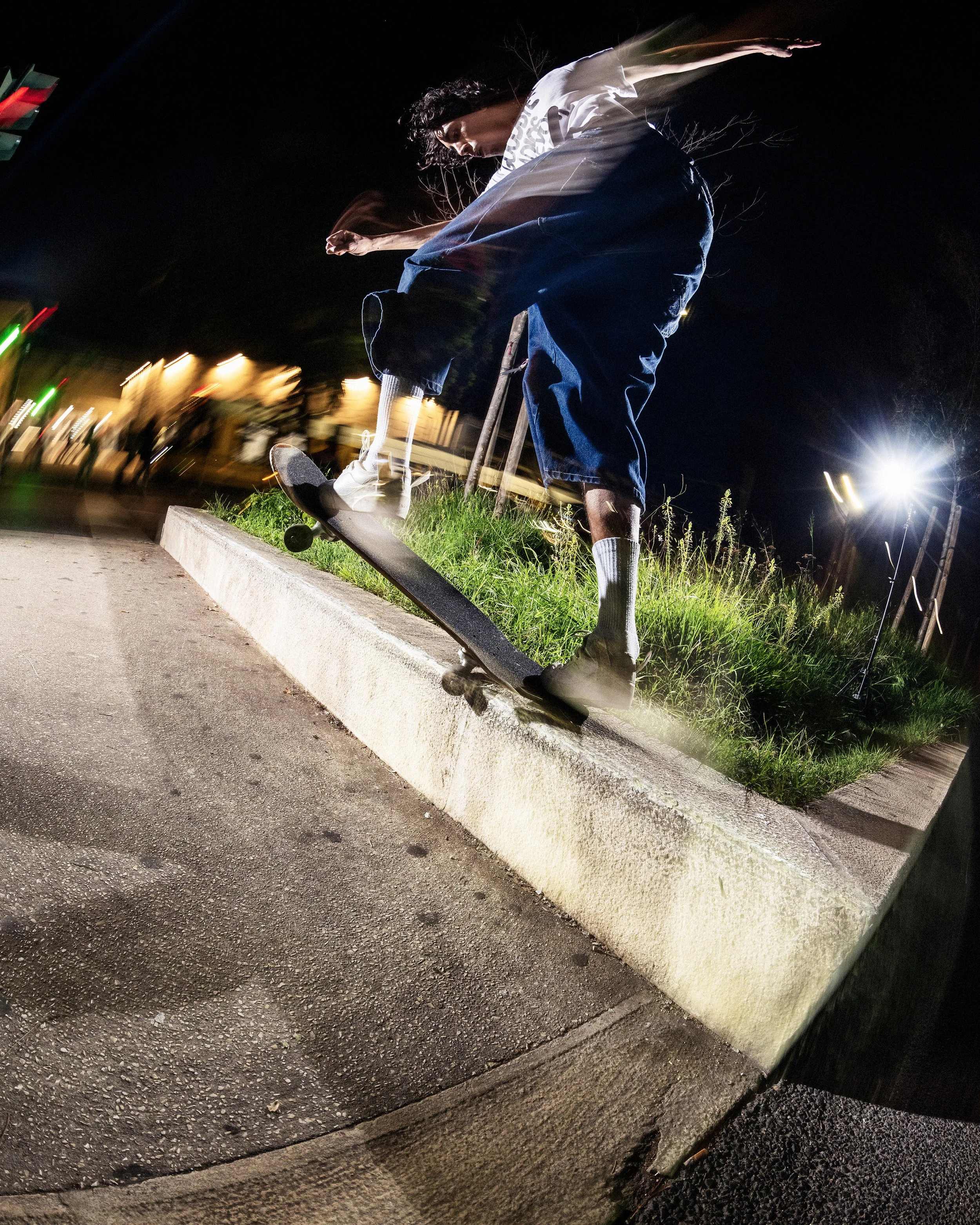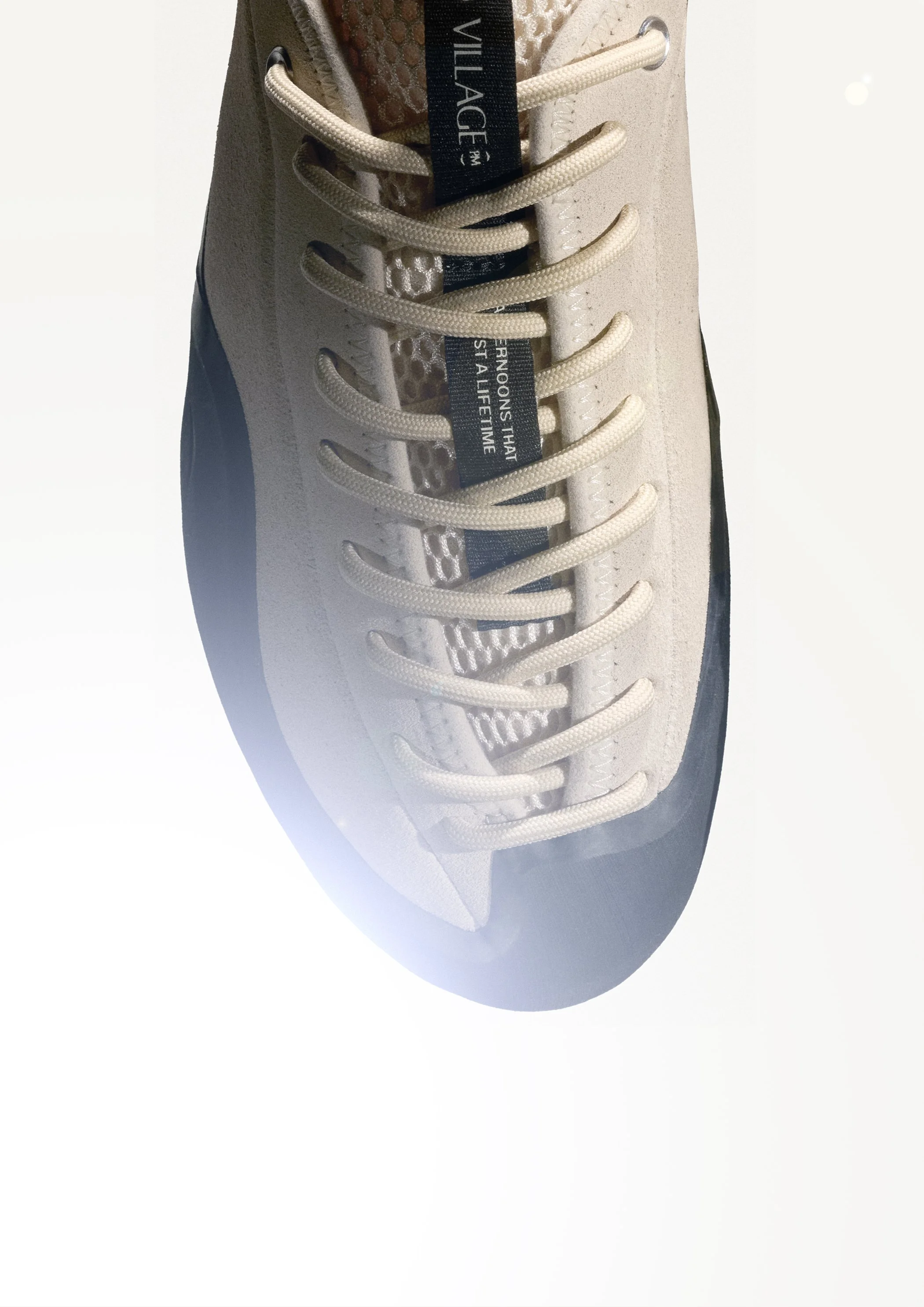Village PM is Creating Progressive Skateboarding Footwear
Images courtesy of them homies, Village PM
It isn’t often that an overly saturated and stale industry is presented with something completely new.
The Paris-based skater-owned Village PM has done exactly that, bringing something unseen and unexpected to skateboarding footwear. Their intention is to create ‘progressive skateboarding footwear’, footwear that is fresh, exciting, aesthetically nice, and most of all performs well. Their debut model the 1PM ticks all those boxes, taking inspiration from climbing footwear, for a sleek silhouette, with a suede upper wrapped in an extremely durable rubber rand, and an asymmetrical toebox for more precise performance, than a traditional rounded toebox. The shoe is durable and looks good, good enough to not have to change shoes to go to the bar after your skate, a blessing.
Village PM officially launched in late March, debuting their first two models the 1PM and 1:30PM and FIRST TIMES ARE SPECIAL, a skateboarding video, by Elliot Bonnabel and Hugo Campan featuring their team of Thaynan Costa, Joffrey Morel, Nico Gisonno, Logan Da Silva Ortiz, Augustin Desiré. It’s not often a shoe company can make a stamp in the industry like this,
Intrigued and wanting to know more about the brand and what they are doing, I spoke to the owners Basile Lapray and Bram De Cleen to talk about Village PM.
One of the first things I found out about Village PM is that you launched the brand at Paris fashion week. I found that really interesting as you’re separating yourself from the traditional skateboarding narrative of wanting to be removed from fashion, and jumping into it. Was creating something that could live between the two worlds of fashion and skateboarding a goal when creating Village PM?
Basile Lapray: Yes, but it isn't a marketing strategy or a precise goal that we set ourselves. We are skateboarders but we are interested in a lot of different things and different worlds, including fashion. It just felt natural for us to create a skateboarding brand with a point of view that is interesting enough to be fresh to other people, not just skateboarders.
Bram De Cleen: That was one of the starting points of view that we had. We felt that skateboarding has become broader than it used to be, and it is communicating with a lot of other different universes, with fashion being one of them. We felt that footwear was one of the only product segments or spaces within skateboarding that hasn’t branched out and touched other things. You see a lot of skaters do things in other universes, and same as skateboarding related clothing brands, but not in the skater-owned footwear space.
Do you think having the background at Salomon and Arc’teryx influenced that? Those are two brands who entered the fashion market and introduced themselves to a new demographic, where they weren’t just used by the outdoor type, but inner-city fashion enjoyers. Was that an approach you wanted to bring to skateboarding?
Bram: We’re aware that we are making a skateboarding shoe and it might be interesting elsewhere, but that’s been the reality of so many products within or outside of skateboarding for a long time. Skateboarding has been used to market vintage basketball shoes for example, they’re all communicating vessels.
Basile: It’s natural for us. We know that we are making a shoe that is interesting in a way or interesting enough to go to other distributions, not just skateboarding. However, the product and brand will always remain skateboarding focused.
For sure, it is also really cool you released a video and announced the team with the launch of the shoes, going down the traditional skateboarding route.
Bram: That is very important for us, not even just from a branding point of view, just from where Basile and I come from, we are skateboarders. What we wanted to do was start a skateboard footwear brand.
Basile: Even with our background in footwear, especially outdoor footwear, the easiest thing businesswise would’ve been to put out a running or an outdoor shoe, but we wouldn’t be able to put our soul into something that isn’t a hundred per cent skateboarding and isn’t backing skateboarding. That is the main thing for us. Having a team, making videos and backing skaters is just as important as making shoes.
When you look at the shoe, the first thing you notice is that it doesn't look like a skate shoe, and it being a skate shoe isn't implied either. Where does the influence come from in the design of the 1PM?
Basile Lapray: It has a big climbing influence. Part of my family lives in Chamonix, which is like the mecca of mountaineering in Europe. I've been influenced by mountaineering footwear since I was a kid. I find it really exciting as a product, with its function, and the way it looks, they’re visually so strong. Working at Salomon I was surrounded by the outdoor footwear industry, and I saw so many interesting things that I thought could be transferred into a skateboarding shoe. From climbing shoes things like the asymmetrical toe box, which is more precise than a rounded toe box, the combination of suede and rubber, with rubber going all around its side walls. These design factors were functional but also visually appealing for us. Skateboarding footwear has always been influenced by other footwear, whether it was basketball or tennis shoes, and we thought it was time to transfer a new footwear DNA into a skateboarding shoe.
Bram De Cleen: We were both looking forward to having something that is really good to skate in but also looks good enough that you’re still down to wear after skateboarding. We both reached a point where we were wearing skate shoes just to skate in and other shoes to freshen it up afterwards.
Yeah, and that’s what was exciting for me with the shoe. It doesn’t look like a skate shoe but more something I would want to wear on a day to day when I'm not skateboarding. I’ve always thought climbing shoes looked cool, so it was nice to be like this is a climbing shoe that you could wear around.
Bram: Thank you, that is great to hear.
How are you going to follow up the 1PM? Are you still going to stick to the climbing shoe theme?
Basile: We’ll see, it’s in discussions but right now it’s too early to say. Our goal is to make a skateboarding shoe where it is not written “skateboarding shoe” and we will continue to develop shoes that reflect that.
Bram: We are really happy with the 1PM, so we are building on top of that. The direction we are heading in, we will communicate that later, but we really love the silhouette, we want to refine it and keep working on it.
Do you feel like you’ve put yourself in a box launching the brand with this distinct and unique shoe or do you think it’s been a good thing?
Basile: We wouldn’t have taken so much risk in starting a shoe brand not to have a unique point of view, we wouldn’t have done this to just make classic vulcanized skate shoes. The market is so saturated that if you’re bringing something new to it, it should be new. In that way I feel like it’s a compliment from you to think we have put ourselves in a box, it means it at least feels different.
Bram: I feel like we have created this space for us to do things more differently. We did the 1PM and 1:30PM that is one story that we are really proud of and happy to build on top of and to push and claim as ours. When we started the brand, we said we would always seek inspiration from wherever we find it, anything that’s inspiring from a footwear perspective or otherwise would be fair game. Maybe we’ve created a little space that looks like us now, but we are definitely down to do something else if we are inspired to do something else.
Basile: But it has to tick some boxes, it has to be functional, function will always be at the centre of what we do. We try to claim progressive skateboard footwear, which is something that you can read as you want.
Yeah, definitely. Speaking on the function, how long did it take to find the right rubber for the shoe, because obviously it’s different to having a normal vulcanised sole, the rubber is such a big part of the shoe.
Basile: It took a while. We went through a long process to find a formula we were happy with. We got some Blazers and Last Resorts and put rubber sheets on the side to test them to see which one would be the best before working with the shoe design. Bram tested so many different rubbers until we were happy with the formula.
Bram: Yeah, basically I would do 50 kickflips and 50 fakie flips. Checking in on the way with how the shoe was feeling, if the rubber was soft enough or if it was too hard, how my kickflips were feeling, how the shoe looked, and if it had worn down already. We did that to a bunch of different rubber formulas stuck on different shoes. We had the first rubber formula we liked on our first sample and redid the whole thing there, keeping on tweaking it until we were happy with it.
Basile: Then sending first prototypes to the people who were skating for the brand as well. Logan [Da Silva Ortiz] was involved early in the development process. He even skated shoes that basically didn’t even have an outsole.
Bram: The first prototype that Logan skated had the upper that was pretty close to what we now have, but the outsole was just this generic flimsy bit of rubber to close the upper off and to call it a shoe [laughs]. Logan was like this is sick, but the outsole is pretty thin. He skated it for a while, he even has a trick in the Pop Trading Co video in the shoes. We took all the feedback that Logan and the team had on board.
Were you able to find a rubber you guys were happy with?
Bram: Yeah, we were able to develop the rubber to have the exact flick we wanted, and also to last, but we didn’t realise how long it would really last [laughs].
That’s really good to hear. The shoes are currently only available in Europe, I know that there has been demand elsewhere. Are there any plans to have shoes in shops globally in the near future?
Bram: We would love to see the shoe to go outside of Europe, but for now we are a very small team, and we like to do things decently so it’s important for us that we will be ready to do that when we do. We may make a few exceptions for the second season, selling outside of Europe and see how we can build on that. We are a very small team at the moment, and we would like to have the brand present when the product goes elsewhere, we don’t want to just send shoes out and not do anything else there. We are taking it step by step for geographical expansion.
Basile: We are very lucky to have this demand from around the world, the reception to the launch has been really nice. But it is also a matter of being a small company and growing financially. You need to do it step by step and we don’t have the ability to finance global expansion. We are looking forward to it.
To see stockists and get a pair of Village PM’s click here.







